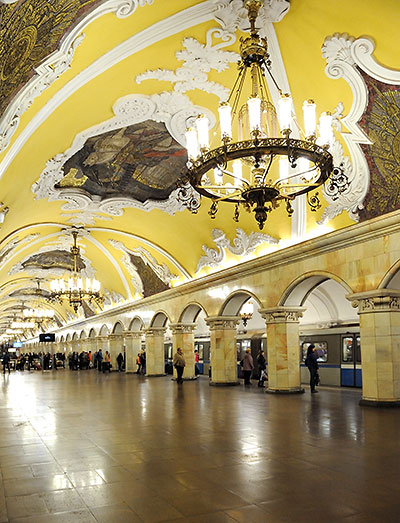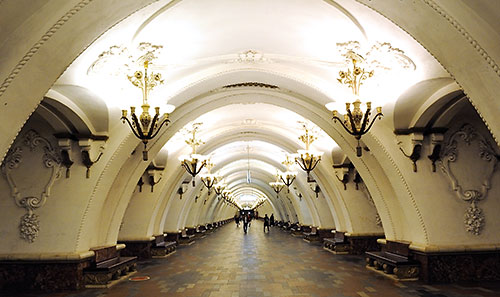The free, pdf’d, certified-as-official-and-requested-by-absolutely-no-one transitophile guide for English speakers navigating the Moscow Metro is online at:
https://transitophile.com/chango/files/moscowmetroguide.pdf
The 200+ mile Moscow Metro carries more yearly riders than any earthly subway system outside of Beijing, Shanghai and Seoul. The lion’s share of construction credit has to go to the maniacally paranoid Stalin, who masterminded a propaganda showcase for the dizziest fantasies of utopian Communism — the baroque grandeur of the Komsomolskaya station, the other worldly beauty of Mayakovskaya — even as millions rotted in his gulags.

I know of no other transit system as magnificent, or any that sprang from such a brutal past. The American press had little reason to publicize a Communist country subway at the height of the Cold War, no matter how spectacular; many Americans have never heard of it.
Anyone with a fleeting interest in twentieth century history would want a look. For a transit geek, it’s close to a holy grail.
But there’s a problem.
The Moscow Metro’s signage is in Cyrillic. Cyrillic, as in: ПЕРEХОД НА КОЛЬЦЕВУЮ ЛИНИЮ. Or maybe ПЕРЕХОД ПРЕКРАЩАЕТСЯ В 1 ЧАС НОЧИ, if ПЕРEХОД НА КОЛЬЦЕВУЮ ЛИНИЮ didn’t quite skip off the tip of your tongue. I wanted to see it, but not if I had to learn to read Brothers Karamazov in the original just to get around.
Last month I visited Europe partly to see if any of the transit meccas I’d read about in years past lived up to their billing. (Zurich and Copenhagen certainly did, and Stockholm came close, but that’s the stuff of another post.) Moscow is only nine hundred miles southeast of Stockholm. I wasn’t planning to return to that neck-of-the-world anytime soon. It wasn’t necessarily ‘Moscow Metro now or never,’ but it was close.
I decided to take the chance. Maybe I’d get hopelessly lost, wander the city for hours, fall into the hands of the KGB and be interrogated for fomenting unrest in the Ukraine. So what? Hadn’t I spent decades working with small children who think anyone over thirty is ready for the coffin anyway? I’m retired. I’d lived long enough to see the original episodes of Mr. Ed, hadn’t I? Who could ask more of life than that? Let the KGB do what they would!
I applied for my visa and dove into online research. Many web sites were eager to tell me about Moscow Metro architecture, but I found only one — http://bridgetomoscow.com/moscow-by-metro — that tackled the challenge of Cyrillic signage. I pored over posts in travel forums, and made two judgment calls before I left that I became immensely grateful for once in Russia:
- Tourist guides might emphasize English names for Moscow Metro stations, but I would not let those guides mislead me. The Cyrillic names were what counted. Maybe I couldn’t read or sound out Славянский бульвар, but Славянский бульвар was what I was going to see on signs down there, and not the English ‘Slavyansky bulvar.’ If anything, ‘Slavyansky bulvar’ was a potentially dangerous distraction. I could regard Славянский бульвар s a word symbol, and be ready for it.

- I would bring along easily-read, jumbo-sized copies of a first rate map.
I almost skipped this step. Wasn’t I going to the city where the metro operated? Wouldn’t I be certain, simply certain, of finding a selection of excellent maps there? Or at the airport, perhaps. Surely in Moscow!
Well, I never did. Maybe you Muscovites know where I should have stopped. I asked at two KACCA ticketing windows, and was politely directed to gaze at maps mounted on the wall.
The Art Lebedev Studio took Moscow’s prize for best metro map, and generously provides the map’s .eps file online. Alas, said map is Cyrillic only, and I regard .eps as a file format for graphic pros.
If you visit the site of second place winner Ilya Birman, you’ll find a huge Cyrillic/English map as a .pdf. That was what I wanted. I have a photo printer, so could make my own 16 x 13 print at home. If I hadn’t had that printer, I could have spent a few bucks to get jumbo copies done by Kinko’s or Staples.
I printed two copies, wound up giving one away to a grateful UK tourist, and spent half my metro riding time with the second map between my nervous fingers. In-dis-pen-sable.
How about a computer app? The Yandex Moscow Metro app will let you load a map, but in Cyrillic only or English only. The Cyrillic map would be worlds better than no map at all, but I used the Ilya Birman map far more often, and had no use for the Yandex trick of figuring out the best route by tapping origin and destination stations. I could do that with my eyeballs.
* * * * *
Travel from touchdown at Sheremetyevo International Airport (where Edward Snowden holed up) to the Aeroexpress train’s end-of-the-line at Moscow’s Белорусская terminal was easier than expected. Russia seems willing to coddle Sheremetyevo travelers; I found an English information kiosk, and English signs showing the way to the Aeroexpress. I also met a good Samaritan onboard, who generously chaperoned me to the KACCA ticket window to buy a Тройка IC card loaded with sixty rides.
But now my good Samaritan was gone, and I was through the fare gates, and on my own.
The next hour was nervous making. (And might have been well nigh impossible, had it not been for that page at bridgetomoscow.com.) I wanted to find the No. 5 Brown Line, but felt like I was hunting for it at the livestock auction at Ulan Bator, for all I could grok of the Cyrillic Дs and Иs and жs. Through corridor after corridor I tugged my rollaboard, ignoring the crush of riders that swarmed past on all sides, squinting hopefully at each new sign and suppressing anxiety as I found it as unhelpful as the last. I meandered onto a platform, watched a train pull up. Maybe I should just follow the herd onto it. Maybe I was at an unusually confusing station. Maybe the Metro would make more sense in that magical Somewhere Else!

Thankfully, I resisted that urge, and soon enough deciphered the first clue of the jigsaw puzzle: I kept seeing words like Динамо and Аэропорт because I was stumbling about near the Green Line, and not the Brown Line I sought. The fog cleared a bit. I found a Brown Line sign, found a Brown Line platform, almost got on a train going the wrong way, realized my mistake, and triumphantly boarded the train I wanted. I continued to grope and fumble on the system for many hours more, but was a vastly more confident traveler by the following morning. By late morning, I could navigate the Moscow Metro almost as easily as a subway in the U.S.
How much easier it could have been, thought I, with even a threadbare manual! On my last day in Moscow, I spent an hour photographing subway signs, in the hope of crafting that manual after my return to the states.
* * * * *
A few notes:
- I left Shanghai convinced that even off-the-cuff instructions could get most tourists from Pudong Airport to any subway station. Shanghai’s English signage is that good.
I am much less bullish about Everytourist’s prospects in the Moscow Metro. I harbor modest hopes that my tutorial will enable English speakers to navigate the maze more comfortably, but also can too easily imagine some getting in a nice mess down there, particularly if unaccustomed to subways and disposed to panic in crowds. Don’t say I didn’t warn you.
- Yes, the .pdf instructions are detailed, and then some! I know all of you rolled out of bed and turned on the computer today by yourselves. I’d still rather provide too much detail than too little.
- My friend on the Aeroexpress told me that many young Muscovites spoke English. That turned out to be a very good thing to know in sometimes-bewildering Moscow. I had no luck with anyone over thirty, in or out of uniform, but would guesstimate that I drew English answers out of nearly forty percent of the young approached with my dazed tourist questions.
(When you pose questions of that young English speaker, please remember that fluency is not a thing possessed or not possessed, like an iPhone app or a tumor, but a matter of degree. Speak slowly and clearly, avoid slang and try to restrict yourself to English 1A vocabulary.)

- How about the Metro’s red/blue towers labeled SOS, with a button to press for Information? I pressed it, and reached an operator in seconds. She spoke no English.
- Moscow Metro trains run as often as every ninety seconds. If in any doubt about the ID of an arriving car, just let it come and go, and board the next one. The only significant waiting I did was between 5:30 and 6:00 a.m., when the Metro is just waking up.
- Maybe there are better ways to do it, but I learned to confine my study of signage to station names, route numbers and colors, and the ubiquitous выход в город for exit to the city. I ignored everything else. I wasn’t going to understand it, and figured I didn’t need it.
- I didn’t try to figure out how to identify different station exits. Maybe I should have, as I was often frustrated to emerge topside blocks from where I wanted to be.
- Some Metro stops join three different subway lines; the Библиотека имени Ленина stop joins four. Expect confusion in such places, less because of the Cyrillic signage than because you’re trying to find your way in a maze.
* * * * *
More information: Amazon will accept $4.50 for a short propaganda pamphlet on the Moscow Metro penned by one Y. Abakumov, published in the thick of Stalin’s Great Purge in 1939. This twenty-four page dollar shred will at least coax a smile from some readers with the paragraphs below:
The Central Committee of the Bolshevik Party called upon the entire country to take part in building the subway of the capital.
The country eagerly responded to the call. Scores of thousands of people flocked to Moscow from all ends of the vast Soviet Union.
Abakumov would be gratified to know that Texas Republicans flock as eagerly to their post offices every April to pay taxes.
Wikipedia has a long post about the Moscow Metro, but my favorite articles were all locked up on JStor. Thankfully, I could access these gratis through my San Francisco Public Library account, and expect that library card holders elsewhere can do the same.
If you have time for only one article, I suggest Andrew Jenks’ Metro on the Mount, at http://www.jstor.org/stable/25147594 .
* * * * *
The image files used in the guide are in a directory of their very own, at: https://transitophile.com/chango/files/moscowmetro/
If you’d like to see other photos from my trip, please click the Moscow album on my Flickr page.